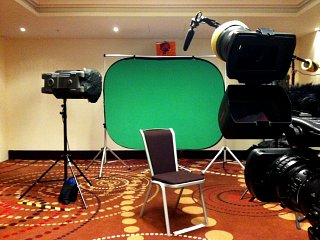Tips for Appearing on Video

Making your 60 Second Video Pitch
We all know that time is of the essence when trying to pitch your business, and on video it’s vital you get the message, as well as the look and feel, right because your video pitch will be viewed over and over on line. Creating the right impact in 60 seconds means you need to plan accordingly, so here are some top tips on what you need to consider:
Key Messages
If you can access autocue, then having your words already coming up in front of you, with your eye line directly to camera, will help take some of the pressure off of having to remember what you wanted to say, and keep you engaged with your viewers. When you’re speaking to a live audience you would probably have some cue cards with your bullets points on; autocue is the video equivalent. It does take a little bit of practice to get used to using autocue, but once you’ve tried it a few times you’ll find it helps ease your delivery.
A key tip here is to remember that you are in control of the speed of the text, so the faster you go the faster the text rolls; with that in mind, make a conscious effort to try to pace yourself, and remember to leave ‘listening’ space and not to rush straight from one line to the next.
Body Language
Make sure you look at the camera so that it will appear as if you are talking directly to your audience on line. This can be difficult if you’ve not done camera work before as the difference between a live presentation and a video recording is that the camera is innate, and doesn’t respond to you in the way that a live audience would. It can be a bit off putting to not get any response, and it’s not unusual for less experienced presenters to grind to a halt on camera!
A good tip here is to treat the camera as if it were a person, make eye contact with the lens in the same way as you would with a real person. Some people find it helpful to put a photo of someone they care about over the camera, or just to image the camera is that person. Make sure you don’t stand rigidly still either, our normal body movement is something that keeps the audience engaged so hand gestures and head movements are perfectly acceptable and necessary. That said, try not to turn into a demented windmill and start waving your arms and hands around wildly – that sort of over reaction will quickly get irritating for your viewers.
Practice Makes Perfect?**
It’s really important to practice saying your pitch out loud before you get to the studio or recording session. Do your practice in different positions, so standing, sitting in an armchair, perched on table and so on – this will help you to learn the context of what you want to say so that it becomes familiar and natural. Practice on family and friends, taking note of their reactions and how engaged they are in what you are saying.
A useful tip here is to record yourself practicing and then listen back to yourself to check that your delivery flows and that your message comes across in a clear and logical way. Also sometimes when you practice like this you’ll ad lib a little gem here and there that you’ll want to put into your final script, so it’s good to have a record of what you said!
Make your Content Concise and Targeted
Think very carefully about what you want to say and how you are going to say it. You need to get your message across very succinctly – keep it simple, clear and well targeted. You need to be passionate about your message and the words you use must reflect that, so avoid using cliches and tecyhnical acronyms; everyday language that reflects your personality and character will be far more powerful.
Warm Up
It might feel a bit odd, but vocal warm ups will help you speak clearly, audibly and with fluidity. It you feel awkward doing vocal exercises in front of people, take yourself off to the bathroom or other private space to exercise your jaw and mouth. A good way to do this is to use a couple of sayings that get the mouth and lips working; so for instance: ‘Red Leather, Yellow Leather’ repeated several times over will help you separate the words out more easily, and you’ll notice how you have to make your tongue work more precisely to get the ‘L’ of leather clear. For the ‘S’ sound try, ‘Sister Susie Shows Shirts for Sailors’ and you’ll notice how you have to concentrate on creating the right shape with your lips to get the ‘s’ sounds precise. If that’s just a step too far, then simply do some pretend yawns to get your jaw loosened up, and combine with some deep breathing exercises to open your chest and help you to phrase more comfortably.
Hope these few tips are useful to you, and if you need any further help with your first appearance ‘on camera’ for a webshotz, the Take One TV team will be delighted to hear from you.








